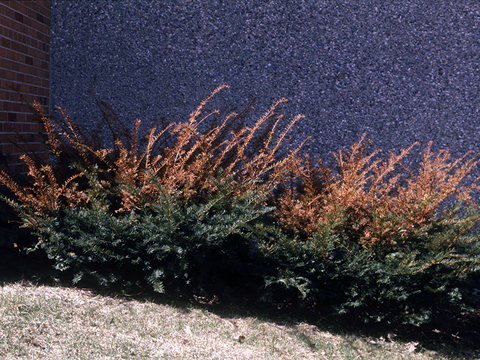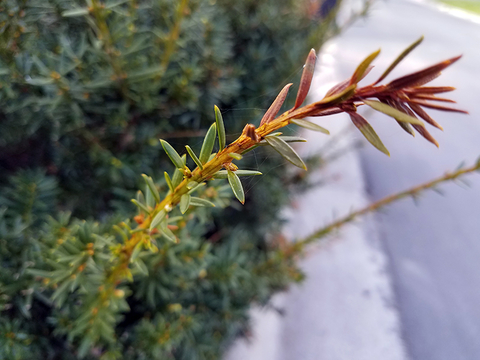Without a doubt, it has been a weird and wacky winter from a gardener’s standpoint. We went into winter in drought conditions in much of the state and the minor snow precipitation never really made a difference.
So here we are on the brink of spring, with dry soil and wide temperature swings. While these conditions can be hard on all plants, we may see more obvious damage on evergreens, particularly in the form of burning, browning and bleaching.
Evergreen foliage burning, browning and bleaching
Winter sun and wind can result in excessive foliage water loss (desiccation) and because the soil is frozen, plant roots are unable to replace lost water. This happens on bright sunny winter days when plant tissue warms up and cell activity is initiated.
When the sun sets or goes behind clouds or buildings, the temperature drops, injuring or killing evergreen foliage. This typically affects the south, southwest and windward sides of plants, with severe cases affecting the whole plant. Most vulnerable are newly transplanted trees and shrubs, especially yew, arborvitae and hemlock, and plants with succulent, late-season growth.
Snow cover provides protection for branches, stems, roots and foliage. Snow cover acts like a protective mulch, moderating soil temperatures as seasons change and providing moisture as plants come out of dormancy in spring. Lack of snow cover puts plants at risk of winterburn and also root damage as dry soil is colder than moist soil.
Browning or death can result when young plant foliage is subjected to freezing temperatures early in fall and plants are not yet hardened off (acclimated) to cold temperatures. Burning and browning can also happen when we have cold temperatures in late spring after bud break. Bright, cold winter days destroy chlorophyll, an important pigment in plants used to make food during photosynthesis. Chlorophyll does not re-synthesize below 28◦F, which can result in “bleaching” or lightening of plant foliage. Bleaching is especially noticeable on boxwoods.
Reducing evergreen winter injury
- Keep evergreens watered through the growing season and up until the soil freezes. Just watering in late fall does not help reduce injury and overwatering can stress plants as they go into winter. See Watering trees and shrubs.
- Do not prune trees and suburbs after August as it induces new growth that will not harden off before winter.
- Anti-desiccant and anti-transpirant sprays are not effective means of protecting evergreen foliage.
- Plant evergreens (yew, hemlock, arborvitae) on the north and northeast sides of buildings and in protected areas to avoid intense winter sun and desiccating winds.
- Cover and protect evergreens. Create barriers with burlap or similar material on the south, southwest, and windward sides of evergreens. You can also surround sensitive trees, leaving the top open to allow for some air and light penetration. Pine boughs or discarded Christmas tree greens can also be used to cover and protect evergreens.
When evergreen injury has occurred
Brown foliage on evergreens is most likely dead and will not green up. However, the buds on evergreen branches such as yews are more cold-hardy than the needles and likely will grow and fill in. Wait until mid-spring to prune injured foliage and see if buds start to swell. If buds have not survived and the branch is dry and snaps when bent, prune dead branches back to living tissue.
As the growing season emerges, focus on reducing plant stress. This allows the plant to put its energy into recovering from winter damage.
- Fertilize injured plants in early spring.
- Keep soil moist over the root zone.
- Mulch to protect the plant roots and stems from drought and mechanical damage.
- Fence plants as needed from animal browsing.
- Provide appropriate winter protection the following year.



